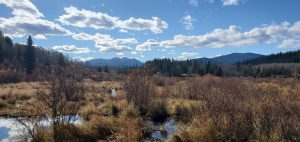Webinaire SCSH: Une exploration des approches pratiques à la modélisation des caractéristiques des zones humides dans un milieu urbain (Anglais seulement)
Surface water-groundwater interactions play an important role in governing the ecological function of wetland features. Sophisticated numerical techniques to assess surface water-groundwater interactions at a range of spatial scales are becoming increasingly accessible to Canadian practitioners. Two case studies will be presented describing the practical application of integrated surface water-groundwater modelling techniques to the assessment of wetland features in an urban setting.
When: May 24th, 2023 @ 1 – 2 pm ET
Where: Zoom
Who:
Michael Takeda from GeoProcess Research Associates,
Christian Gabriel and Daron Abbey from Matrix Solutions
Description of case studies to be presented:
- A parking lot located within an urban stream corridor in Hamilton, Ontario is slated for removal and reclamation. In its place, a wetland feature has been proposed, which will be fed by a combination of precipitation, runoff and several groundwater springs surrounding the site. The water balance analysis forms an important component of the overall feasibility assessment for the proposed wetland design. Using this project as a case study, alternative water balance assessment approaches were undertaken to compare the insights gained from 1) a simple monthly water balance, 2) a distributed and continuous hydrologic model, 3) a 3D steady-state groundwater model, and 4) an integrated surface water-groundwater model. Each of these approaches incorporates some set of simplifying assumptions and approximations when representing the wetland water balance, with groundwater feedback mechanisms such as rejected recharge, groundwater discharge, and shallow depth to water represented with varying levels of rigour. This case study discusses the potential suitability, data requirements, spatial scale, level of effort, and possible limitations of each approach when applied to the same local scale study area.
- Residential development is planned for the southern portion of the City of Guelph, Ontario which intersects the Paris Moraine, a landscape characterized with hummocky, rolling hills, generally well-drained soils and complexes of wetlands isolated from any watercourses. Subwatershed scale integrated surface water-groundwater modelling identified the potential for significant increases in future wetland water levels under the planned development, with the potential to negatively impact aquatic habitat. Various alternative stormwater management options were simulated/evaluated for their effectiveness in maintaining the hydroperiod based on a multi-decade simulation. A catchment-scale MIKESHE model was developed to provide an understanding of (a) which wetland-related features were most important to sustaining its hydrologic and ecological functions, and (b) which suite of management responses, including source control stormwater management systems and optimized locations and orientations for centralized flood storage infiltration systems, would be most effective at mitigating the potential change in hydroperiod as the planned development proceeds.



